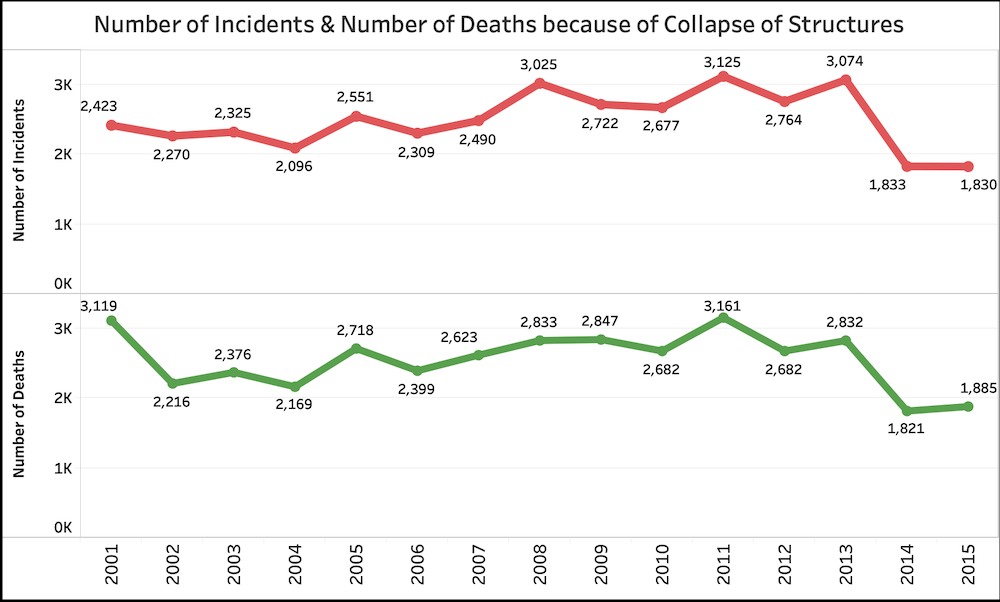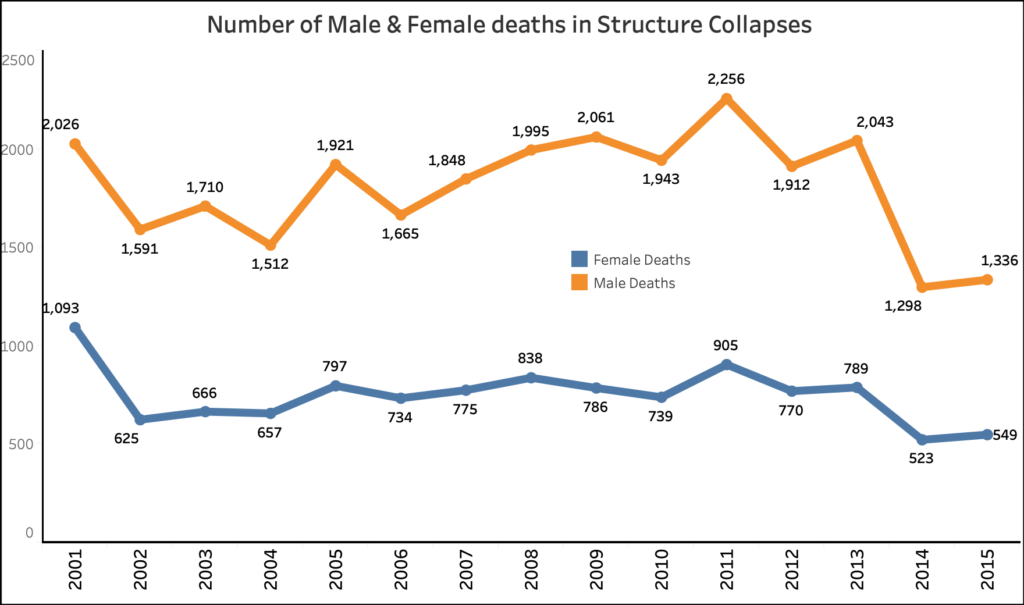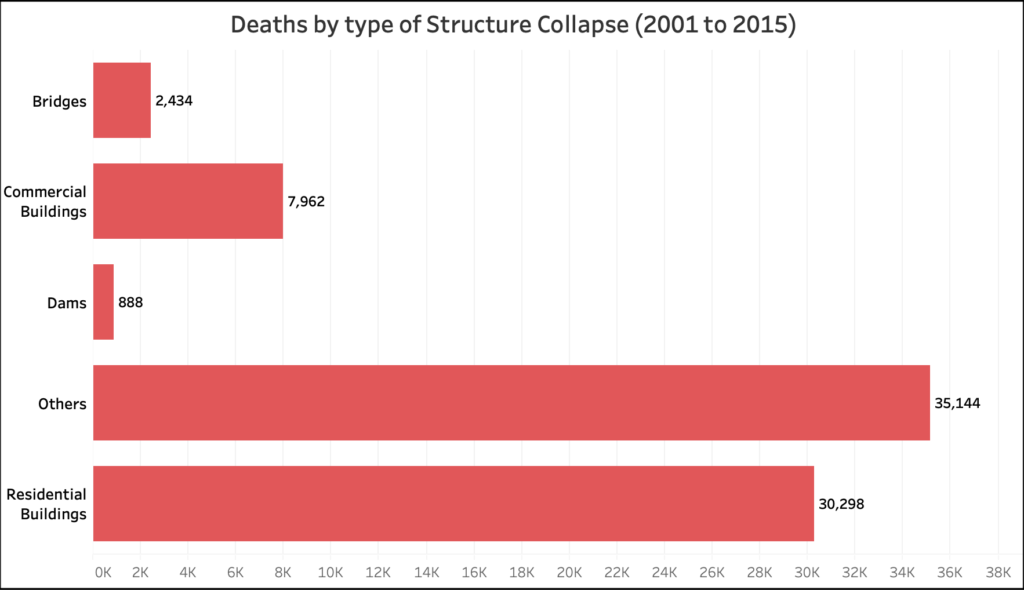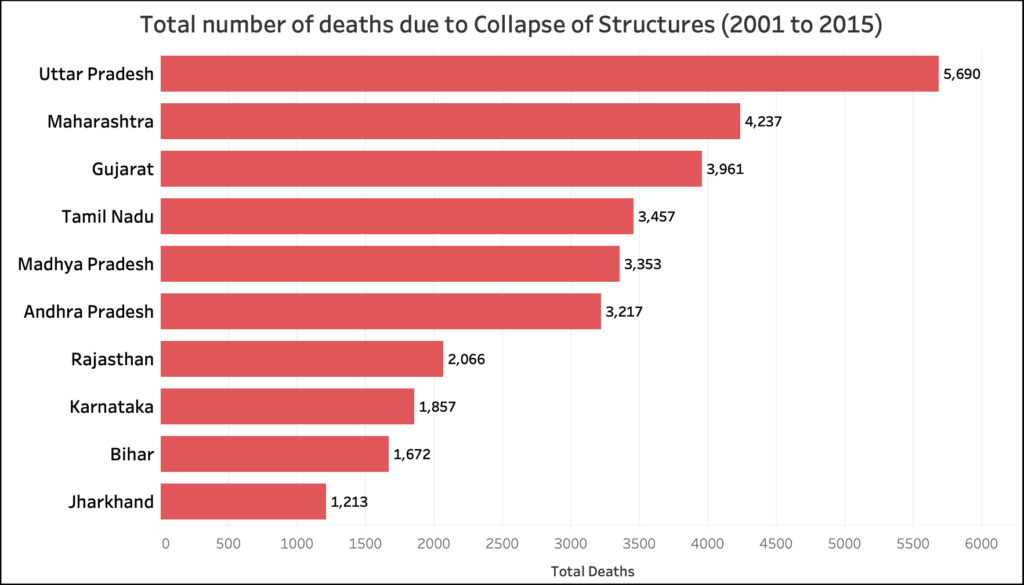[orc]Data from the National Crime Records Bureau (NCRB) indicates that a total of 38363 people lost their lives due to collapse of various structures between 2001 and 2015. Most people lost their lives because of the collapse of residential houses.
About 10 people lost their lives when a building collapsed in Mumbai on 16 July 2019. This is close on the heels of another accident in Pune when a wall collapsed claiming more than 10 lives. But this is not an isolated incident. Data collated by the National Crime Records Bureau (NCRB) indicates that 38363 people lost their lives due to the collapse of various structures in 37514 incidents between 2001 and 2015. In 2015, the year up to which latest data is available. A total 1885 people lost their lives due to collapse of structures in 2015.
Number of deaths have decreased over the years, but still high
The NCRB collates this data in its annual report ‘Accidental Deaths & Suicides in India’ (ADSI). Various un-natural causes of death are listed in this report and collapse of various structures is one the causes captured by the NCRB. Unfortunately and for reasons unknown, the NCRB hasn’t published this report after 2015. The latest data available is only up to 2015.
The number of incidents of structure collapse has been going up and down in the last 15 years. The highest number of such incidents occurred in 2011 when 3125 structures collapsed. The total number of incidents was more than 3000 each in 2008, 2011 and 2013. In a welcoming sign, the number of incidents was less than 2000 in both 2014 and 2015. These are the only two occasions when the number of incidents was less than 2000. On average, there were 7 such incidents of structure collapsing per day between 2001 and 2015.

In terms of number of deaths, more than 3000 deaths were reported in both 2001 and 2011, the only two occasions when the death toll was more than 3000. In eleven other years, the death toll was more than 2000. Like in the number of incidents, the death toll was also less than 2000 in both 2014 and 2015.
Male death toll is 2.5 times the Female death toll
The male death toll was more than 27000 in these 15 years while the female death toll was a little over 11000. In five of these 15 years, the male death toll was more than 2.5 times the female death toll. 2001 is the only year when the female death toll was more than half the male death toll.

40% of the deaths because of the Collapse of Residential buildings
The NCRB categorizes the data on collapse of structures into 5 different categories. Between 2001 and 2015, more than 15000 people lost their lives because of the collapse of residential buildings which account for about 40% of all the deaths. A total of 3981 people lost their lives because of the collapse of commercial buildings or 10% of the total death toll. Collapse of dams & bridges together accounted for about 4% of all the deaths. Rest of the 45% of the deaths were due to the collapse of other structures like flyovers etc.

Most deaths in the bigger states
As expected, most such deaths took place in the bigger states. Uttar Pradesh accounted for most number of deaths (5690) followed by Maharashtra (4237), Gujarat (3961), Tamil Nadu (3457) and Madhya Pradesh (3353) in the top five. More than 1000 people lost their lives due to collapse of structures in each of the eleven states. Of the bigger states, Punjab, West Bengal, Odisha & Kerala had less than 1000 deaths in these 15 years.

Between 2001 and 2015, Mumbai reported more than 100 deaths in both 2005 and 2013 because of structure collapses. The death toll was more than 50 in six of the fifteen years and was less than 50 in the rest of the 7 years. Since 2010, the death toll was more than 50 only in 2013.
There are hundreds of dilapidated buildings across the country. Mumbai alone has 700 such structures as per government data. Further, as per the DISE survey of 2016-17, 0.67% of the school buildings in the country are in a dilapidated condition. Unless all such structures are identified and remedial action is initiated on war footing, the loss of lives due to collapse of structures will continue.



2 Comments
Pingback: Read To Know The Average Of Structures Collapsed In India Per Day, In The Last 5 Years | My WordPress Website
Pingback: Mumbai building collapse: In India, homes crashing down are deadlier than floods — Quartz